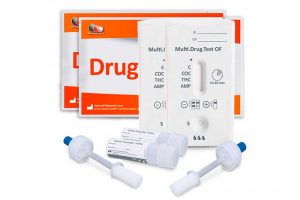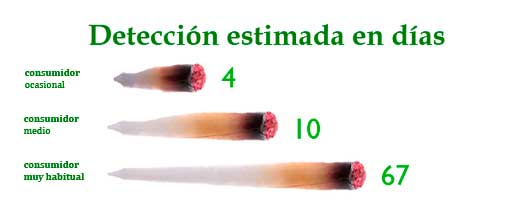
In recent times, saliva drug tests have gained prominence and have become a common tool in workplace, traffic, and sports situations to detect the use of prohibited substances.
This type of test is very popular due to its ease of administration, quick results, and low cost. It is important to note that these tests simply provide a positive or negative result for consumption, regardless of the quantity or type of substance used.
Thus, a therapeutic CBD user will also test positive in a roadside saliva drug test, leaving many wondering how to test negative in a saliva drug screening.
Saliva Drug Tests
A saliva drug test is a non-invasive procedure used to detect the presence of psychoactive substances in the body. These biochemical tests are useful tools for detecting recent drug use, both in occasional and regular users.
Unlike urine tests, which can detect drugs over a longer period, saliva tests have the advantage of providing immediate results, usually within 10–15 minutes. Common substances detected in saliva tests include: Marijuana (THC), cocaine, opiates (such as morphine and heroin), methamphetamines, benzodiazepines, and MDMA (ecstasy).
Additionally, saliva analysis allows for both drug and alcohol testing at the same time, which is why these tests are applied to drivers — they are used to determine whether a person is driving under the influence of drugs or alcohol.
How Saliva Drug Tests Work
Saliva tests work by analyzing a saliva sample collected with a small absorbent device. This is placed in the mouth, usually under the tongue, to obtain a sample that is then processed in a testing device.
The detection process is based on identifying drug metabolites in the saliva. Metabolites are the by-products that the body produces when it processes a drug. Depending on the substance used, the time that metabolites remain in saliva varies, but in general, detection is most effective within the first few hours after consumption.
Unlike urine or blood tests, saliva tests allow for the immediate detection of drug use. That is, they can produce a positive result in just a few minutes. This is where their great efficiency lies as a drug detection tool: they can be administered easily, and their results are immediate.
Factors Affecting How Long Cannabis Remains in Saliva
The duration of cannabis in the body depends on several factors, such as the amount consumed, frequency of use, type of product, individual metabolism, and method of consumption.
In general, to know how long THC stays in the body, one should consider the psychoactive effects of THC, which usually last between 2 and 6 hours after consumption, depending on the form of intake (smoked, vaporized, eaten, etc.).
However, THC can remain in the body much longer. In occasional users, it can typically be detected in urine for 3 to 7 days after consumption, while in regular or chronic users, it can remain detectable for up to 25 days or more.
There are several factors that can influence the result of a saliva drug test, and it’s important to understand them before attempting to clean the sample to obtain a negative result. The most relevant factors include:
-
Time since consumption: Saliva tests are most effective for detecting recently consumed substances. Marijuana, for example, can remain in saliva for 1–3 days, depending on the amount consumed and frequency of use. However, for other substances such as cocaine, the effects may disappear in as little as a few hours.
-
Personal metabolism: People with a faster metabolism can eliminate toxins from their bodies more quickly than those with a slower one. Factors such as age, weight, overall health, and physical activity level can influence how fast a person removes drugs from their system.
-
The type and amount of drug consumed, since the metabolization process of some drugs lasts longer than that of others.
-
Personal condition: Fatigue, drowsiness, anxiety, or other illnesses can affect the time it takes for the body to break down and eliminate the drug.
-
The level of hydration: The more hydrated the body is, the faster drug traces tend to disappear. Therefore, the amount of liquids consumed (water, juice, etc.) can help dissolve and eliminate certain drug residues more quickly.
As for the cutoff point — the threshold at which a result is considered positive — it varies slightly depending on the test kit manufacturer. However, it is usually between 10 and 20 nanograms per milliliter (ng/ml). Thus, if two saliva samples are taken, the final laboratory result will be the one considered valid.
When Saliva Drug Tests Are Most Commonly Used

Saliva tests are relatively new. In our country, they are mainly used as a method to monitor excessive drug use among drivers.
When necessary, traffic officers carry out saliva drug tests preventively on drivers who display reckless behavior.
If the initial test result is negative, consumption is ruled out. This is why such tests are considered preliminary or screening tests; they simply indicate whether the driver tests positive or negative.
However, if the test is positive, a second saliva sample is collected. That sample is then sent and analyzed in a laboratory, where the type and amount of drug consumed are determined.
According to the Spanish Directorate-General for Traffic (DGT), 98.5% of preliminary tests are accurate. This conclusion is supported by the fact that their results coincide with those obtained from toxicology laboratories.
How Can I Test Negative in a Drug Test?
It’s important to note that there is no 100% guaranteed method to test negative in a saliva test, especially if the substance was consumed recently. However, there are several strategies that can help reduce the likelihood of a positive result — strategies we already detailed in a previous article on our blog.
In addition to the strategies described in our previous article, here are three more that can also help:
-
Oral hygiene: Mouthwash, chewing gum, and deep oral cleaning can help reduce the concentration of drug metabolites in saliva, but they will not completely eliminate toxins. Some people choose to perform intensive oral hygiene using antibacterial mouthwash, saltwater, or baking soda to reduce drug traces in the mouth before testing.
-
Stay calm: Stress can alter metabolism, so staying calm and relaxed may help prevent stress from interfering with the body’s natural detoxification processes.
-
Use of specialized products: There are products on the market designed to help cleanse the system quickly. Some of these include drinks or rinses specifically formulated to help remove toxins from saliva.


